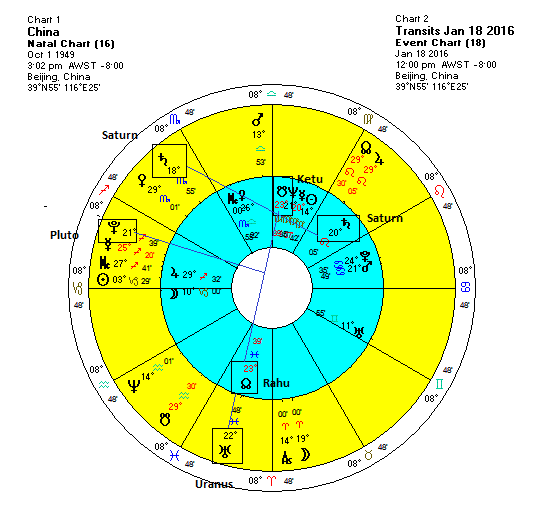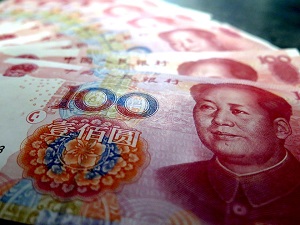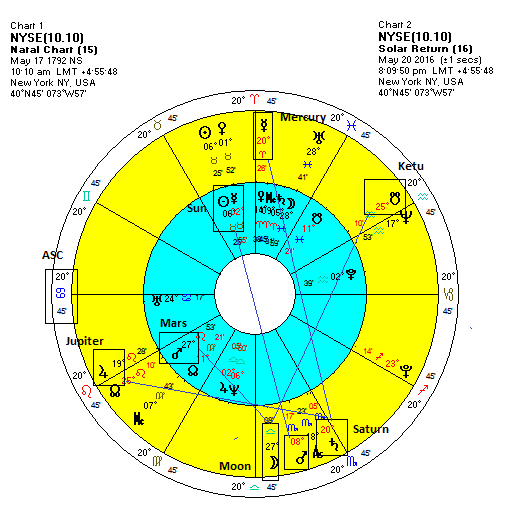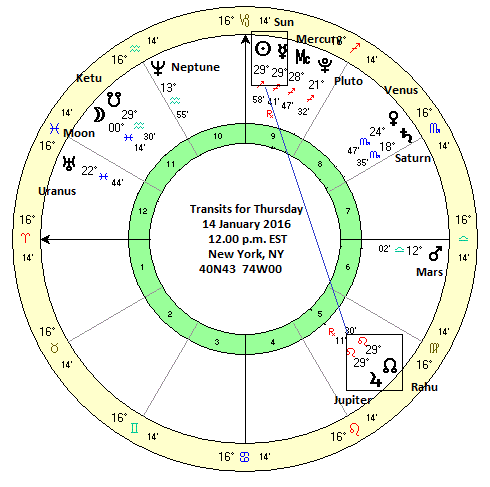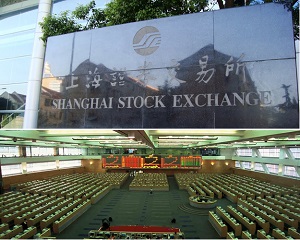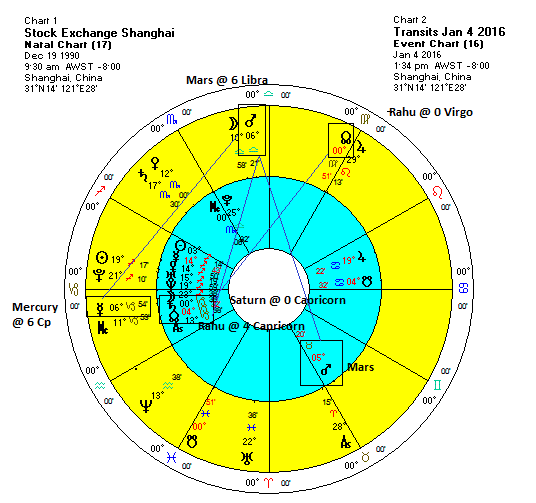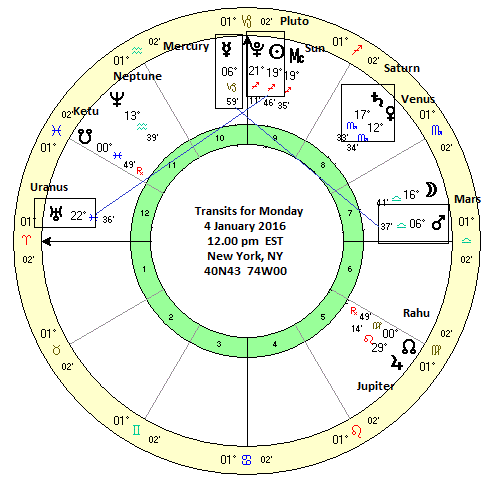 (25 January 2016)
Are we there yet? Investors are wondering if this January decline
might finally be done with or if this is only be a nasty prelude to a
more tumultuous financial year in 2016. My assessment of the planetary
influences suggest there is a higher than normal risk of more downside
in both the short and medium term. There are several useful charts in
this respect but perhaps none is more important these days than the
chart for crude oil futures.
(25 January 2016)
Are we there yet? Investors are wondering if this January decline
might finally be done with or if this is only be a nasty prelude to a
more tumultuous financial year in 2016. My assessment of the planetary
influences suggest there is a higher than normal risk of more downside
in both the short and medium term. There are several useful charts in
this respect but perhaps none is more important these days than the
chart for crude oil futures. As we have seen, the stock market is currently being driven by oil prices. If oil falls, stocks also fall soon after. One reason for this close correlation is that oil prices have fallen so far that many oil companies are in financial trouble. Most have laid off workers, and some are on the verge of insolvency. In particular, some US-based companies borrowed heavily for capital-intensive shale fracking operations. As these companies go under, they will no longer be able to repay their debt and hence the banks that loaned them money will also be in trouble. The financial contagion will thereby be released upon a vulnerable economy. As the world's pre-eminent commodity, crude oil prices are also seen as a proxy for the state of the global economy. The falling prices in the oil market are signaling that the economy is slowing as China and other emerging markets cut their consumption levels amid rising debt.
The bottom line here is that as oil goes, so goes the stock market. If oil falls further, it seems very likely that stocks will also fall further. A rebound in oil either through tightening supply or increasing demand, or conceivably a fall in the US Dollar would give a boost to the stock market. So what is the price outlook for oil?
Previously, I looked at the Brent Crude Oil horoscope and found strong evidence for depressed prices in 2015, 2016 and beyond. Not surprisingly perhaps, a quick look at the first trade horoscope for West Texas Intermediate (WTI) on the NYMEX also shows why the oil market is so weak at the moment. As is so often the case, the planetary cause of falling prices is Saturn. Transiting Saturn (19 Scorpio) is in a tight conjunction with Jupiter (17 Scorpio) in the 7th house of the chart opposite the Ascendant,. Secondarily, Saturn is also conjunct nearby Uranus (15 Scorpio).
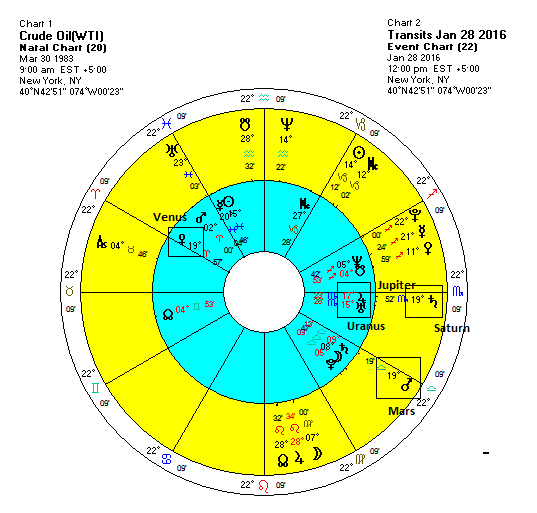
Saturn was exactly conjunct Jupiter two weeks ago when crude oil fell through support at $35 -- a moment of maximum affliction by Saturn. While Saturn's bearish influence may be lessening to some extent since it is now past exact, it may not travel far enough away from Jupiter to make much of a difference in terms of overall trend. Saturn is due to station retrograde at 22 Scorpio in late March and then come back and conjoin that natal Jupiter once again in June. We could easily see another push lower then. As the most distant of the observable planets, Saturn only moves 12 degrees per year including a four-month long retrograde period and thus its conjunctions can take many months to play out. It therefore seems likely that Saturn's proximity to natal Jupiter will mean that oil will fall further in 2016, possibly reaching that $20 target that many analysts have highlighted. Saturn stations direct in August at 15 Scorpio and will then conjoin that Jupiter once again in September. As a general rule, Saturn conjunctions are bearish for prices for most assets.
To be sure, the entirety of the collapse of oil prices since 2014 cannot be solely accounted for by the movements of Saturn. The initial price decline was also associated with Ketu (South Lunar Node) which conjoined Mars (2 Aries) in mid-2014 at the start of the decline below $100 and then later, in part, through its conjunctions with Mercury (20 Pisces) and Sun (15 Pisces). That said, these simple transits do not account for all of the variation in the price of oil but they play a large role in determining if oil is rising, falling or going sideways.
The near term outlook looks challenging. Saturn may be losing some of its negativity but the planets this week argue for more downside. The late week transit of Mars (19 Libra) opposite the natal Venus (19 Aries) in the WTI horoscope may well coincide with significant downside, especially since it also aligns with Saturn. February could see some improvement but the gains may come in fits and starts and probably won't be enough to change the overall bearish outlook for oil. March seems a lot more difficult as Saturn stations and begins to move back towards Jupiter again.
Weekly Market Forecast
Stocks bounced last week as crude oil finally reversed its downturn. US Stocks rallied 2% on the week after making a potentially significant intraday low on Wednesday while Indian stocks enjoyed a more modest gain. While I was somewhat bearish in my bias in last week's market forecast, I was uncertain if the ongoing alignment of retrograde Mercury with Pluto, Uranus, Saturn and Mars would yield declines last week or this week.
This week is off to a mixed start as Asian markets were somewhat higher while European stocks finished a bit lower. US Stocks are down by less than 0.5% and crude is down by 3% as I write this post. I still think there is a greater risk of declines this week even if we get some upside along the way. We will see Mercury station direct later on Monday (EST) so that could change the mood of the market. And the Mars-Saturn alignment will tighten on Thursday and Friday so that may be a more likely time when stocks will fall. Interestingly, Fed Chair Janet Yellen is due to issue its latest policy statement on the economy on Wednesday. For more details and a longer term forecast for February and beyond, please subscribe to my MVA Investor Newsletter.

